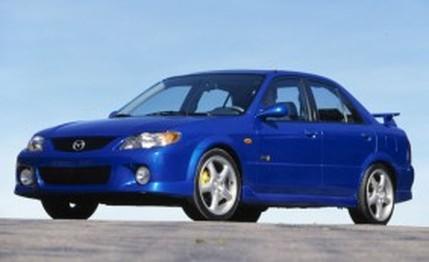
 First Drive Review
First Drive Review
Dolphins. The Mazda Protegé MP3 is inhabited by dolphins. Their little pixilated bodies duck and weave across the dashboard reminding you that your ears are going to waste. Should you heed the message and put power to the stereo, a blazing iridescent quasar vaporizes Flipper and begins pulsing in a spectral orgy to the thump of the giant subwoofer. It may sound as though we've snorted the whole bag of nutmeg, but not this time. The MP3's 280-watt Kenwood Excelon Z919 head unit has a multicolor LCD that, when off, is populated by marine life and when on routinely performs a perfect imitation of Tokyo's Ginza district at midnight.
Flip down the motorized faceplate (after locating the appropriate tiny button with an electron microscope), and a CD slot appears. It accepts regular store-bought discs or self-burned jobs encoded with MP3 digital audio computer files. Hence, the name of this car and a big chunk of its $2230 premium over a similarly equipped Protegé ES manual. The sumptuous sound from this radio and its 10-inch cochlea-compressing subwoofer seems as good as most bookshelf systems, but its presence alone isn't quite enough to get the resident rev heads here salivating. Particularly since the miniature controls require a degree in enigmatology — the hand-held remote is thankfully simpler — and the display vanishes like Brigadoon in direct sunlight.
Fortunately, the MP3 has some other noteworthy tweaks that bump the roadability value above the more pedestrian Protegé models. They include mild engine and suspension upgrades for which Mazda relied on tuner Racing Beat in Anaheim, California, an established company carrying street credibility with the slammed-Civic set. Co-founder Jim Mederer and his crew had helped put together the original MPS show car for last year's SEMA aftermarket-parts show and have delivered a production version virtually unchanged. Helping out the firmer springs and thicker roll bars are Tokico shocks and stiffer control-arm bushings. They interface with the road through 17-inch cast aluminum Racing Hart wheels encased in 205/45ZR-17 Dunlop SP Sport 9000 rubber, and with the driver through a leather-bound Nardi three-spoke wheel.
The 2.0-liter DOHC four gets an algorithmic stimulant in the form of reprogrammed ignition timing. That and the Racing Beat exhaust downstream of the catalyst are worth 10 horsepower and 7 pound-feet of torque, says Mazda, raising the cranking capability to 140 horsepower and 142 pound-feet of torque. Racing Beat gets featured billing on the MP3's trunk badge for its effort. The Protegé has long been a favorite around these parts. The last-generation car clobbered 12 other compact sedans in our "Little Cars 6.1" comparo in June 2000 with its fair impersonation of a BMW 2002. In a rematch, the extra vigor of the Protegé MP3 would likely guarantee it the Stirling Moss Award. The major reason is that Mazda builds the econocar equivalent of a battleship hull and wires it with light, precise, and communicative controls.
From the thick steering wheel, ergonomically sculpted buckets, and machined-steel pedals, the Protegé MP3 streams data to your appendages regarding lateral grip, slip angle, and road irregularity. You feel the car's organs working to digest corners. You also feel the understeer, but it rotates the MP3's rear satisfyingly when you back out of the throttle lightly, a trait that helped the car post a blazing 0.85 g on the skidpad. A new Protegé 5 wagon tested the same day riding on 16-inch Dunlops managed just 0.79 g. In traffic, the manual MP3 has all the twist-and-lean squirt of a sport bike, minus the favorable power-to-weight ratio, though. In fact, power is something of which the Protegé could certainly handle more. The 8.2-second 0-to-60-mph dash and the 16.3-second quarter-mile are admittedly breezy for the segment; the MP3 beats all the "Little Cars" (the Hyundai Elantra GLS and the Chevy Prizm come within a 10th or two) and trails a Miata to 60 by only a 10th. But this is no Subaru Impreza WRX. The twin-cam four generates far more sound than fury in its cast iron belly, enough decibels at mid-rpm to begin poisoning the atmosphere for the stereo. And what do you have in the MP3 without the stereo and that extra smidgen of g in cornering ability? Dolphins.